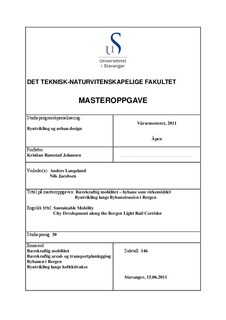| dc.contributor.author | Johansen, Kristian Ramstad | |
| dc.date.accessioned | 2011-10-07T16:36:06Z | |
| dc.date.available | 2011-10-07T16:36:06Z | |
| dc.date.issued | 2011 | |
| dc.identifier.uri | http://hdl.handle.net/11250/181988 | |
| dc.description | Master's thesis in Urban development and design | en_US |
| dc.description.abstract | The realization of the Bergen Light Rail indicates a change in the Norwegian land use and
transportation politics. Even though the term sustainable development has existed and been
used among planners, administrations and politicians during the last 24 years, the actual
development has shown that we have not been able to change the negative tendencies of
increased pollution and emissions, larger material and energy consumption and lack of
consideration of the environment and ecosystems.
The first part of this thesis describes why it is so important to plan land use and transportation
development in a sustainable way. Chapter 4 gives insight on how the term is being used in
norwegian planning guidelines, national and regional plans, and potential consequences if
today’s development persists. Strategies and processes to approach sustainable city
development are presented in chapter 5, based on existing theory and study results.
The Bergen Light Rail provides a unique opportunity to arrange long term land use
development along the rail corridor that can strengthen the position of community transport in
relation to the private car. It is the struggle to reduce car usage that is the key challenge when
planning for sustainable mobility. As long as there are no environmentally friendly
transportation systems that can provide the same opportunities as the car, there is no reason to
believe that we will face changes in the transportation tendencies we have witnessed since the
car revolution the 1960’s. Transition from the private car to public transportation is a large,
complicated and time consuming challenge. Studies indicate that improving environmentally
friendly transport systems is not sufficient – the advantages of car usage must be reduced as
well.
Everything points towards a further growth in Bergen, and to avoid urban sprawl and
structural scenery that favours car usage, this master thesis presents discussion and
suggestions to how future growth can be concentrated to the Light Rail corridor. By
implementing transit oriented development as well as the idea of a more compact city, travel
distances can be reduced, public transportation possibilities can be improved and car usage
can be reduced without interfering with our everyday quality of life. | en_US |
| dc.language.iso | nob | en_US |
| dc.publisher | University of Stavanger, Norway | en_US |
| dc.relation.ispartofseries | Masteroppgave/UIS-TN-IØRP/2011; | |
| dc.subject | bærekraftig mobilitet | en_US |
| dc.subject | bærekraftig areal- og transportplanlegging | en_US |
| dc.subject | bybane | en_US |
| dc.subject | urban design | en_US |
| dc.subject | byutvikling | en_US |
| dc.subject | Bergen | |
| dc.subject | light rail | |
| dc.subject | transport | |
| dc.title | Sustainable mobility, city development along the Bergen light rail corridor | en_US |
| dc.type | Master thesis | en_US |
| dc.subject.nsi | VDP::Social science: 200::Urbanism and physical planning: 230 | en_US |
